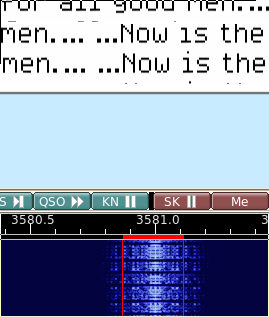Table of Contents
Hellschreiber modem
All Hellschreiber modes are based on character scanning, reproducing characters in a similar way to a dot-matrix printer. This technique uses a digital transmission, yet allows the received result to be interpreted by eye, a similar concept to the reception of Morse by ear. The character is scanned upwards, then left to right. There are typically 14 pixels (transmitted dot elements) per column (although single pixels are never transmitted) and up to seven columns per character including inter-character space.
These remarkably simple modes are easy to use, easy to tune, and although not especially sensitive, are entirely suited to HF/VHF since they use no sync and the eye can discern the text even in high levels of noise. fldigi can operate in the following :
Hellschreiber modes
| Mode | Symbol Rate | Typing Speed | Duty Cycle | Bandwidth |
|---|---|---|---|---|
| Feld-Hell | 122.5 baud | ~ 2.5 cps (25 wpm) | ~ 22% | 350 Hz |
| Slow Hell | 14 baud | ~ 0.28 cps (2.8 wpm) | ~ 22% | 40 Hz |
| Feld-Hell X5 | 612.5 baud | ~ 12.5 cps (125 wpm) | ~ 22% | 1750 Hz |
| Feld-Hell X9 | 1102.5 baud | ~ 22.5 cps (225 wpm) | ~ 22% | 3150 Hz |
| FSK-Hell | 245 baud | ~ 2.5 cps (25 wpm) | ~ 80% | 490 Hz |
| FSK-Hell 105 | 105 baud | ~ 2.5 cps (25 wpm) | ~ 80% | 210 Hz |
| Hell 80 | 245 baud | ~ 5.0 cps (50 wpm) | 100% | 800 Hz |
Hellschreiber Waterfall
Feld-Hell look like this when being received by fldigi:

Feld-Hell seems to be the most commonly used and use can usually be found on 80 and 40 meters at the high end of the digital sub bands. Extreme linearity is required in the transmit path in order to control the bandwidth of the transmitted signal. Feld-Hell X5, Feld-Hell X9 and Hell 80 should probably not be used on HF in the US. They can be used on VHF and UHF.